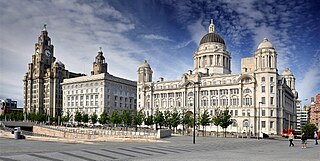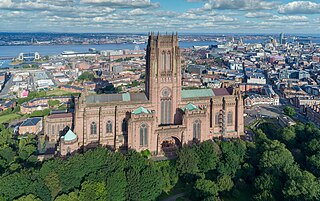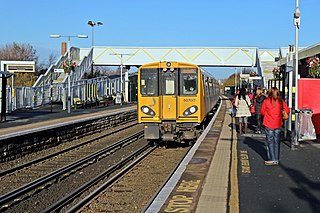
Liverpool is a city and metropolitan borough in Merseyside, North West England. It had a population of 486,100 at the 2021 census. The city is located on the eastern side of the Mersey Estuary, adjacent to the Irish Sea, and is approximately 178 miles (286 km) from London. The wider Liverpool built-up area is the third largest in England and Wales outside London. Liverpool itself is the largest settlement in the Liverpool City Region, which is the fourth largest combined authority in the UK with a population of 1,551,722 in 2021. The city also forms part of a larger urban region of over 2 million people which extends in to the neighbouring counties of northeast Wales, Cheshire and Lancashire. The region shares political boundaries and significant economic connections.

Merseyside is a ceremonial and metropolitan county in North West England. It borders Lancashire to the north, Greater Manchester to the east, Cheshire to the south, the Welsh county of Flintshire across the Dee Estuary to the southwest, and the Irish Sea to the west. The largest settlement is the city of Liverpool.

The River Mersey is a major river in North West England. Its name derives from Old English and means "boundary river", possibly referring to its having been a border between the ancient kingdoms of Mercia and Northumbria. For centuries it has formed part of the boundary between the historic counties of Lancashire and Cheshire.

Birkenhead is a town in the Metropolitan Borough of Wirral, Merseyside, England; historically, it was part of Cheshire until 1974. The town is on the Wirral Peninsula, along the west bank of the River Mersey, opposite Liverpool. At the 2011 census, it had a population of 88,818.

Merseyrail is a commuter rail network which serves Merseyside and adjacent areas of Cheshire and Lancashire. Merseyrail serves 69 stations, 67 of which it manages, across two lines – the Northern Line and the Wirral Line. The network uses 750 V DC third rail electrified lines having 75.0 miles (120.7 km) of routes, of which 6.5 miles (10.5 km) are underground. Since January 2023, Merseyrail commenced replacing its train fleet, withdrawing the Class 507 and 508 trains and introducing 53 new Class 777 trains. The network carried 25.5 million passengers in the 2022/2023 statistical period.

The Pier Head is a riverside location in the city centre of Liverpool, England. It was part of the former Liverpool Maritime Mercantile City UNESCO World Heritage Site, which was inscribed in 2004, but revoked in 2021. As well as a collection of landmark buildings, recreational open space, and a number of memorials, the Pier Head was the landing site for passenger ships travelling to and from the city.
Merseytravel is the passenger transport executive, responsible for the coordination of public transport in the Liverpool City Region in North West England. Merseytravel was established on 1 December 1969 as the Merseyside Passenger Transport Executive. From 1 April 2014, with the creation of the Liverpool City Region, Merseytravel expanded its area of operation from the metropolitan county of Merseyside to also include the Borough of Halton.

Prince's Dock is a dock on the River Mersey, England, and part of the Port of Liverpool. It is the most southerly of the docks situated in the northern part of the Liverpool dock system, connected to Prince's Half-Tide Dock to the north. The dock is now in the buffer zone to one of Liverpool's World Heritage Sites.

Manchester Dock was a dock on the River Mersey in England and a part of the Port of Liverpool. The dock was not part of the interconnected dock system, but was connected directly to the river.

Liverpool City Region is a combined authority area in North West England. It has six council areas; five Merseyside metropolitan boroughs and the Cheshire unitary authority of Halton. The region had a population of 1,551,800 in 2021: it is the fourth largest combined authority area by population in England, outside of London.

The Wirral line is one of two commuter rail routes operated by Merseyrail and centred on Merseyside, England, the other being the Northern line.

Aintree railway station is a railway station that serves the village of Aintree, Merseyside, England. It is on the Ormskirk branch of the Merseyrail network's Northern Line. Until 1968 it was known as Aintree Sefton Arms after a nearby public house. The station's design reflects that it is the closest station to Aintree Racecourse, where the annual Grand National horse race takes place.

The history of Liverpool can be traced back to 1190 when the place was known as 'Liuerpul', possibly meaning a pool or creek with muddy water, though other origins of the name have been suggested. The borough was founded by royal charter in 1207 by King John, made up of only seven streets in the shape of the letter 'H'. Liverpool remained a small settlement until its trade with Ireland and coastal parts of England and Wales was overtaken by trade with Africa and the West Indies, which included the slave trade. The world's first commercial wet dock was opened in 1715 and Liverpool's expansion to become a major city continued over the next two centuries.

Liverpool Central High Level was a terminus railway station in central Liverpool, England. It opened on 1 March 1874, at the western end of the Cheshire Lines Committee (CLC) line to Manchester Central. It replaced Brunswick as the CLC's Liverpool passenger terminus, becoming the headquarters of the committee.

The Birkenhead Railway was a railway company in North West England. It was incorporated as the Birkenhead, Lancashire and Cheshire Junction Railway (BL&CJR) in 1846 to build a line connecting the port of Birkenhead and the city of Chester with the manufacturing districts of Lancashire by making a junction near Warrington with the Grand Junction Railway. The BL&CJR took over the Chester and Birkenhead Railway in 1847, keeping its own name for the combined company until it shortened its name to the Birkenhead Railway in 1859. It was taken over jointly, on 1 January 1860, by the London and North Western Railway (LNWR) and the Great Western Railway (GWR). It remained a joint railway until nationalisation of the railways in 1948.

The Lancashire Union Railway ran between Blackburn and St Helens in Lancashire, England. It was built primarily to carry goods between Blackburn and Garston Dock on the River Mersey, and also to serve collieries in the Wigan area. Most of the line has now been closed, except for the St Helens-to-Wigan section that forms part of the main line between Liverpool and the North.
Liverpool in North West England, is a major British city with significant road, rail, and ferry networks, in addition to an international airport and a well-known dock system. As with most other major UK cities, Liverpool's transport infrastructure is centred on its road and rail networks. Public transport services within the city are controlled and run by Merseytravel.
The following is a timeline of the history of the city of Kingston upon Hull, East Riding of Yorkshire, England.
The following is a timeline of the history of the city of Bristol, England.
Haydock railway station served the village of Haydock, formerly in Lancashire, now in Merseyside, England.



















